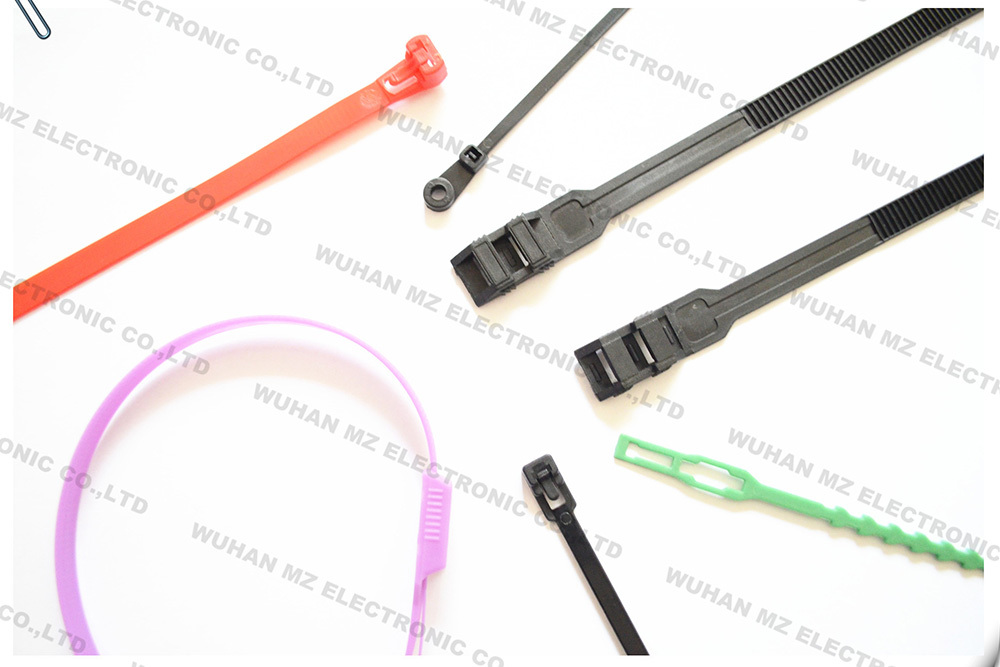24
2025
-
11
Adjustment techniques for perforated plastic cable ties
Author:
Understanding the Locking Mechanism of Pearl-Eye Plastic Cable Ties
Pearl-eye plastic cable ties, also known as snap-lock or quick-release ties, feature a unique locking mechanism that combines durability with adjustability. The key to their functionality lies in the ratchet teeth on the tail and the pawl inside the head. When the tail is inserted into the head, the teeth engage with the pawl, creating a one-way locking action that tightens as force is applied. This design ensures the tie remains securely fastened, even under tension or vibration.
The pearl-eye feature, a small opening near the head, allows for manual release of the locking mechanism. By pressing a tool or finger into this opening, users can disengage the pawl from the teeth, enabling the tie to be loosened or removed without cutting. This makes pearl-eye ties ideal for applications where temporary fastening or frequent adjustments are required, such as organizing cables or securing lightweight objects.
Adjusting Tension Without Tools
One of the primary advantages of pearl-eye plastic cable ties is their ability to be adjusted without specialized tools. To modify the tension:
- Loosening the Tie: Insert a small, flat object (e.g., a toothpick, paperclip, or nail) into the pearl-eye opening. Press gently on the pawl inside the head while pulling the tail backward. This disengages the teeth, allowing the tie to slide looser.
- Tightening the Tie: If the tie is not secure enough, simply pull the tail further through the head. The ratchet teeth will automatically engage with the pawl, tightening the loop. Ensure the tie is snug but not overly tight to avoid damaging the secured object.
This method is particularly useful in scenarios where precision is required, such as bundling delicate cables or adjusting the fit of a temporary strap. The ability to fine-tune tension without tools enhances versatility and reduces waste, as ties can be reused multiple times.
Common Issues and Troubleshooting
Despite their simplicity, pearl-eye plastic cable ties can encounter issues that affect their performance. Here are some common problems and solutions:
- Stuck Pawl: If the pawl fails to disengage when pressure is applied to the pearl-eye opening, the tie may be over-tightened or damaged. Gently wiggle the tool or finger while pressing to encourage movement. Avoid using excessive force, as this can break the tie.
- Slipping Teeth: If the tie loosens unexpectedly, the ratchet teeth may be worn or misaligned. Inspect the tail for damage and replace the tie if necessary. Ensure the teeth are facing the correct direction when inserting the tail into the head.
- Difficult Insertion: If the tail does not slide smoothly into the head, check for debris or obstructions in the locking mechanism. Clean the head and tail with a soft brush or compressed air to remove particles that may hinder operation.
By addressing these issues promptly, users can maintain the reliability and longevity of their pearl-eye plastic cable ties.
Practical Applications and Tips
Pearl-eye plastic cable ties are versatile tools used in a wide range of applications, from household tasks to industrial projects. Here are some practical uses and tips for maximizing their effectiveness:
- Cable Management: Use pearl-eye ties to organize and secure bundles of cables or wires. Their adjustable nature allows for easy reconfiguration as systems are upgraded or expanded.
- Temporary Fastening: In construction or event setups, pearl-eye ties provide a quick and secure way to temporarily bundle materials or equipment. Their manual release feature streamlines cleanup and reduces waste.
- Light-Duty Applications: For securing lightweight objects like hoses, ropes, or small tools, pearl-eye ties offer a cost-effective and efficient solution. Their reusability makes them ideal for scenarios where frequent adjustments are needed.
When using pearl-eye ties, avoid over-tightening, as this can damage the secured object or the tie itself. Additionally, store ties in a cool, dry place to prevent degradation from heat or moisture. By following these guidelines, users can ensure their pearl-eye plastic cable ties perform reliably in any application.
plastic cable ties
Previous Page
Previous Page
Hot News
2025-11-26
The relationship between the width of plastic cable ties and their load-bearing capacity
Plastic cable ties are widely used for securing cables, components, or objects, and their load-bearing capacity is a critical factor in determining their suitability for specific tasks. One of the primary influences on this capacity is the width of the tie, which directly impacts its structural strength and ability to withstand tension.
2025-11-26
The advantage of black plastic cable ties in resisting ultraviolet rays
Clear plastic cable ties, known for their transparency and flexibility, offer unique advantages in scenarios where visibility and subtlety are prioritized. Their ability to blend into surroundings while maintaining secure fastening makes them a practical choice across various industries and environments.
2025-11-25
The advantage of black plastic cable ties in resisting ultraviolet rays
Black plastic cable ties are widely recognized for their superior UV resistance, making them a preferred choice for outdoor and sun-exposed applications. The key to their effectiveness lies in their color and material composition, which work together to mitigate the damaging effects of ultraviolet radiation.
2025-11-25
Colored plastic cable ties are distinguished by their colors for different uses
Color-coded plastic cable ties are widely used across industries to streamline organization, improve safety, and enhance efficiency. By assigning specific colors to different purposes, users can quickly identify and manage cables, components, or equipment without relying on additional labels or tools. This system is particularly valuable in complex environments like data centers, manufacturing floors, or construction sites, where dozens of cables or parts must be tracked and maintained.

